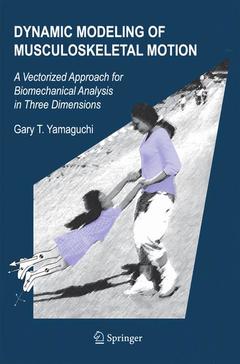Description
Dynamic Modeling of Musculoskeletal Motion, Softcover reprint of the original 1st ed. 2001
A Vectorized Approach for Biomechanical Analysis in Three Dimensions
Author: Yamaguchi Gary T.
Language: English
Subject for Dynamic Modeling of Musculoskeletal Motion:
Keywords
algebra; calculus; complexity; control; development; efficiency; foundation; kinematics; living systems; model; modeling
Approximative price 158.24 €
Subject to availability at the publisher.
Add to cartPublication date: 07-2001
258 p. · 15.6x23.4 cm · Paperback
Approximative price 158.24 €
Subject to availability at the publisher.
Add to cartPublication date: 09-2005
258 p. · 15.5x23.5 cm · Paperback
Description
/li>Contents
/li>Comment
/li>
Dynamic Modeling of Musculoskeletal Motion introduces biomechanists to modern methods of modeling and analyzing dynamic biomechanical systems in three dimensions. Using vector kinematics, the reader is taught a systematic method which significantly reduces the complexity of working with multiple, moving limb segments in three dimensions. Operations which usually require the application of differential calculus are replaced by simple algebraic formulae. To derive dynamical equations of motion, a practical introduction to Kane's Method is given.
Kane's Method builds upon the foundation of vector kinematics and represents one of the most exciting theoretical developments of the modern era. Together, these techniques enable biomechanists to decipher and model living systems with great realism, efficiency and accuracy. Interwoven with the theoretical presentation are chapters and examples which highlight the subtle differences between inanimate linkages and the biomechanical systems we seek to understand.
Now available in a lower priced paper cover edition
Techniques enable biomechanists to decipher and model living systems with great realism, efficiency and accuracy
Chapters and examples highlight the subtle differences between inanimate linkages and the biomechanical systems we seek to understand
Includes supplementary material: sn.pub/extras

